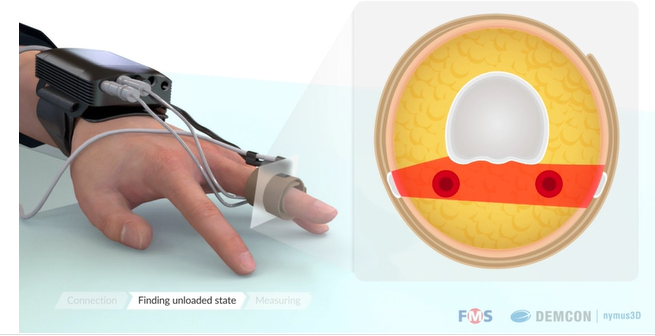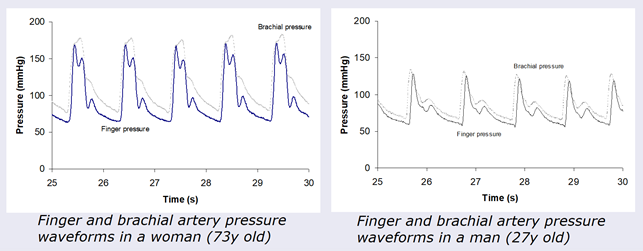Background of the Finapres NOVA Plus Technology
Volume-clamp: continuous BP measurements using a finger cuff
The volume-clamp method was first introduced by Czech physiologist Prof. Dr. J Peňáz in 1973 [1]. He demonstrated that it is possible to perform continuous measurements of the finger arterial pressure by using a finger cuff. This cuff consists of an inflatable bladder and a plethysmograph, which incorporates a light source (LED) and detector. The light is absorbed by the blood, and the pulsation of arterial diameter during a heartbeat causes a pulsation in the light detector signal.
The volume-clamp method was first introduced by Czech physiologist Prof. Dr. J Peňáz in 1973 [1]. He demonstrated that it is possible to perform continuous measurements of the finger arterial pressure by using a finger cuff. This cuff consists of an inflatable bladder and a plethysmograph, which incorporates a light source (LED) and detector. The light is absorbed by the blood, and the pulsation of arterial diameter during a heartbeat causes a pulsation in the light detector signal.
The first step in this method is determining the proper unloaded diameter of the finger arteries. This is the point at which finger cuff pressure and intra-arterial pressure are equal and at which the transmural pressure across the finger arterial walls is zero. Next, the arteries are clamped, to keep them at this unloaded diameter, by varying the pressure of the inflatable bladder using the fast cuff pressure control system [2].
Finding and verifying the setpoint
All Finapres devices incorporate a servo-controller system, which defines a set point and a measured value that is compared with this set point. In this case, the set point is the signal of the plethysmograph (unloaded diameter of the arteries) that must be clamped, while the measured value comes from the light detector. The amplified difference between the set point and measured value, "the error signal", is used to control a fast pneumatic proportional valve in the Frontend Unit / NANO CORE ® module. This proportional valve modulates the air pressure generated by the air compressor. This causes changes in the finger cuff pressure, in parallel with intra-arterial pressure in the finger, to dynamically unload the arterial walls in the finger. The cuff pressure thus provides an indirect measure of intra-arterial pressure.
All Finapres devices incorporate a servo-controller system, which defines a set point and a measured value that is compared with this set point. In this case, the set point is the signal of the plethysmograph (unloaded diameter of the arteries) that must be clamped, while the measured value comes from the light detector. The amplified difference between the set point and measured value, "the error signal", is used to control a fast pneumatic proportional valve in the Frontend Unit / NANO CORE ® module. This proportional valve modulates the air pressure generated by the air compressor. This causes changes in the finger cuff pressure, in parallel with intra-arterial pressure in the finger, to dynamically unload the arterial walls in the finger. The cuff pressure thus provides an indirect measure of intra-arterial pressure.
NANO CORE ® Technology
Finapres Medical Systems launched an updated version of the Finapres NOVA with Finapres technology is now built into the wrist module-which is named the NANO CORE module. This means that the full servo-control system, including electronics, sensors, valves, signal calculations and data transfer are integrated in the wrist module.
Finapres Medical Systems launched an updated version of the Finapres NOVA with Finapres technology is now built into the wrist module-which is named the NANO CORE module. This means that the full servo-control system, including electronics, sensors, valves, signal calculations and data transfer are integrated in the wrist module.
Physiocal: the signal quality indicator
All Finapres devices include a calibration algorithm called Physiocal. This algorithm prevents drifts in the measured finger pressure due to arterial contractions and relaxations, related to smooth muscle activity in the finger arteries. Physiocal defines and maintains the correct diameter (setpoint) at which the finger artery is clamped. Thereby, it is essential for an accurate measurement.
The development and validation of the Physiocal algorithm has been widely described in peer-reviewed literature [2-4]. The Physiocal algorithm in Finapres devices not only uses the amplitude but also interprets the shape of the plethysmograph signal during periods of constant cuff pressure. By analyzing the plethysmograph signal at two or more pressure levels, the Physiocal algorithm explores part of the pressure-diameter relation. Hereby, it is able to track the unloaded diameter of a finger artery, even if the smooth muscle tone changes. The periodic interruption of a finger blood pressure measurement, with constant cuff pressure levels, is further referred to as "Physiocal".
All Finapres devices include a calibration algorithm called Physiocal. This algorithm prevents drifts in the measured finger pressure due to arterial contractions and relaxations, related to smooth muscle activity in the finger arteries. Physiocal defines and maintains the correct diameter (setpoint) at which the finger artery is clamped. Thereby, it is essential for an accurate measurement.
The development and validation of the Physiocal algorithm has been widely described in peer-reviewed literature [2-4]. The Physiocal algorithm in Finapres devices not only uses the amplitude but also interprets the shape of the plethysmograph signal during periods of constant cuff pressure. By analyzing the plethysmograph signal at two or more pressure levels, the Physiocal algorithm explores part of the pressure-diameter relation. Hereby, it is able to track the unloaded diameter of a finger artery, even if the smooth muscle tone changes. The periodic interruption of a finger blood pressure measurement, with constant cuff pressure levels, is further referred to as "Physiocal".
Starting a new measurement
At the start of a measurement, the signal needs to be calibrated because small microvessels under the finger cuff are being emptied from blood. Since this effect is more pronounced immediately after starting a blood pressure measurement, a Physiocal procedure is scheduled initially after every 10th heartbeat. As soon as the setpoint has become sufficiently stable, this interval is gradually increased to every 70 beats, normally within 4 minutes.
At the start of a measurement, the signal needs to be calibrated because small microvessels under the finger cuff are being emptied from blood. Since this effect is more pronounced immediately after starting a blood pressure measurement, a Physiocal procedure is scheduled initially after every 10th heartbeat. As soon as the setpoint has become sufficiently stable, this interval is gradually increased to every 70 beats, normally within 4 minutes.
If the stability of the setpoint cannot be confirmed, eg after movement artifacts, or if the change in setpoint is considered too large, the frequency of Physiocal will temporarily increase automatically. Hereby, the Physiocal frequency is an important signal quality indicator.
Physiocal is available in all Finapres devices. Users can determine whether they wish to use the Physiocal algorithm. They can switch it off during tests in which uninterrupted data-collection is required.
Physiocal is available in all Finapres devices. Users can determine whether they wish to use the Physiocal algorithm. They can switch it off during tests in which uninterrupted data-collection is required.
Moving from finger arterial pressure (fiAP) to brachial arterial pressure (reBAP)
Finapres devices enable measurements of continuous arterial blood pressure in the finger. It is important to realize that the finger arterial pressure may differ from the blood pressure measured in the brachial artery or aorta. This is caused by pulse wave distortions, resulting in differences in the blood pressure waveform and pressure gradients, caused by flow, resulting in a different absolute pressure levels.
These graphs, obtained from [5], show finger and brachial pressure waveforms from a woman (73y old) and a man (27y old).
Finapres devices enable measurements of continuous arterial blood pressure in the finger. It is important to realize that the finger arterial pressure may differ from the blood pressure measured in the brachial artery or aorta. This is caused by pulse wave distortions, resulting in differences in the blood pressure waveform and pressure gradients, caused by flow, resulting in a different absolute pressure levels.
These graphs, obtained from [5], show finger and brachial pressure waveforms from a woman (73y old) and a man (27y old).
All Finapres devices include a reconstruction technique that generates a reconstructed brachial artery pressure, called reBAP, based on the measured finger arterial pressure. This reconstruction technique applies both waveform filtering and level correction [6-8]. It allows clinicians and researchers to obtain the brachial arterial pressure if they wish to perform a more precise measurement at the heart level. The reBAP signal is real time available.
The blood pressure signal of the Finapres NOVA NANO CORE meets accuracy requirements of AAMI / ANSI / ISO 81060-2: 2013 standards, with the radial artery as used reference site.
The blood pressure signal of the Finapres NOVA NANO CORE meets accuracy requirements of AAMI / ANSI / ISO 81060-2: 2013 standards, with the radial artery as used reference site.
References:
- Penaz, J. "Photoelectric measurement of blood pressure, volume and flow in the finger" In: Digest of the 10th International Conference on Medical and Biological Engineering. " Dresden 104 (1973).
- Wesseling, KH "Physiocal, calibrating finger vascular physiology for Finapres." Homeostasis 36 (1995): 67-82.
- Imholz, Ben PM, et al. "Fifteen years experience with finger arterial pressure monitoring: assessment of the technology." Cardiovascular Research 38.3 (1998): 605-616.
- Langewouters, GJ, et al. "Why use Finapres or Portapres rather than intra-arterial or intermittent non-invasive techniques of blood pressure measurement?" Journal of medical engineering & technology 22.1 (1998): 37-43.
- Rongen, Gerard A., et al. "Comparison of intrabrachial and finger blood pressure in healthy elderly volunteers." American journal of hypertension 8.3 (1995): 237-248.
- Gizdulich, Paolo et al. "Models of brachial to finger pulse wave distortion and pressure decrement." Cardiovascular Research 33.3 (1997): 698-705.
- Westerhof, Berend E., et al. "Variable day / night bias in 24-h non-invasive finger pressure against intrabrachial artery pressure is removed by waveform filtering and level correction." Journal of hypertension 20.10 (2002): 1981-1986.
- Guelen, Ilja, et al. "Validation of brachial artery pressure reconstruction from finger arterial pressure." Journal of hypertension 26.7 (2008): 1321-1327.





